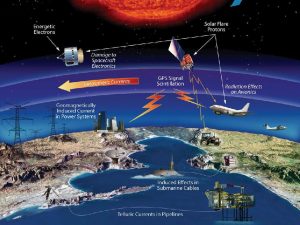May 18, 2018
Safeguard Our Infrastructure by Improving Space Weather Forecasts
Posted by Annika Deurlington
Today’s post is written by Tai-Yin Huang, Professor of Physics, Penn State University
Space weather has become increasingly important due to our heavy dependence on technological infrastructure. Space weather can cause disruptions to telecommunications and GPS navigation, failure or mis-operation of satellites, loss of electricity due to damage to power grids, and damage to pipelines, all of which compromise our personal and national security. Luckily, monitoring space weather conditions and improving our space weather forecasting capability can help us better prepare for when and where infrastructure may be harmed. The ability to prevent or mitigate damage, though, begins with understanding the origins and the effects of space weather on all layers of the Earth’s atmosphere. Consequently, this important topic should be one of the nation’s top priorities.
But what is space weather? Space weather refers to the response of the Earth’s atmosphere to the Sun’s activity. The Sun emits electromagnetic radiation and energetic charged particles through coronal mass ejections (CMEs) and plasma streams. Solar winds and solar flares are massive energetic charged particles ejected from the Sun. When Earth-directed CMEs occur, they can deform the Earth’s geomagnetic field, causing the geomagnetic field to change with time.

Technological infrastructure affected by space weather events. Click for larger image. Image by NASA
How can deforming Earth’s geomagnetic field impact infrastructure? An electric current (voltage) will be induced in a conductor by the principle of Faraday’s Law of Induction. When the currents move underground or through the sea, they are called telluric currents, and they are strongest when geomagnetically-induced. These induced currents pose a potential threat to infrastructure. To illustrate, a geomagnetic storm will induce a telluric current in a pipeline and its surrounding soil, which causes the electric potential difference between the pipeline and the soil to fluctuate. When the fluctuations exceed the safe range, it will compromise the operation of corrosion protection devices, significantly shortening their lifespan and eventually leading to pipeline leaks and environmental damage. Geomagnetically Induced Currents (GICs) can also create a spike in current in the core of a transformer or damage the transformer by heating, causing maloperation of relays and other equipment on the system, and lead to failure of individual electrical lines or collapse of the whole power grid system. Energy supply would be additionally impacted because the drilling industry relies on magnetic surveys, which will not work properly when there is a geomagnetic storm. Geomagnetic storms also can affect high frequency radio communication and satellites in numerous ways like phantom commands, damage to electronics, surface charging, loss of control, and even satellite failure.
The costs of space weather to infrastructure can be high. The 1989 blackout in Quebec that left millions of people without power was the doing of a geomagnetic storm on the Hydro-Quebec’s power grid. Large events are noteworthy, but a new study indicates that the daily U.S. economic cost from solar storm-induced electricity blackouts could be in the tens of billions of dollars (Oughton et al., 2017). And this study doesn’t even include the costs when space weather puts pipelines, satellites, GPS navigation systems, and magnetic surveys out of operation! The overall costs by geomagnetic storms can be extremely high if we are not well-prepared for the space weather impacts.
Space weather forecasting can protect infrastructure. The Space Weather Prediction Center at the National Oceanic and Atmospheric Administration (NOAA) provides daily space weather forecasts and crucial information on geomagnetic storms. Satellites like Solar and Heliospheric Observatory (SOHO) and Advanced Composition Explorer (ACE) measure near-real-time solar data for space weather prediction. Scientists look for patterns and clues in the data to produce a forecast. Data assimilation and modeling of space weather effects can also enhance space weather forecasting. Accurate space weather forecasts allow sufficient time for infrastructure to protect itself from the space weather impacts so that pipeline, power, and telecommunication companies can better manage their systems to be more resilient to the effects of space weather and minimize the risk of interruptions to infrastructure. The airline industry also relies on space weather forecasts to determine whether their pilots should take alternate routes during geomagnetic storms.
The impacts of space weather on our everyday lives are often imperceptible, but they can be disastrous. Both small- and large-scale space weather events create costs for our infrastructure systems. We can minimize these costs if we do a better job in space weather forecasting. Understanding our Sun and how our Earth responds to the Sun’s activities will enable us to develop advanced new technologies to protect infrastructure. However, we can only accomplish these objectives by doing more research. It is high time that the nation prioritizes addressing this vulnerability.

